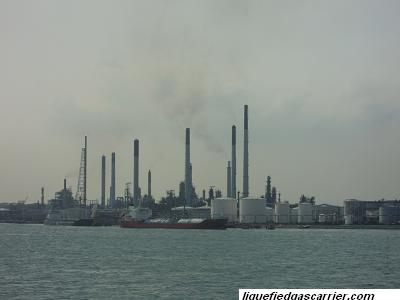

Home page|||
LNG handling |||
LPG handling||| Other Gas products|||
Fire & Safety|||
Emergency response |||
Instruments failure during unloading operations - Recommended actions by liquefied gas carriers
Liquefied natural gas (LNG) compresses to a small fraction of its original volume (approximately 1/600) under liquefaction. With the amount of flammable material that LNG contains, it has the potential to be an extremely dangerous chemical, if handled improperly. The liquefaction of natural gas raised the possibility of its transportation to many destinations.
An emergency can occur at any time and in any situation. Effective action is only possible if pre-planned and practical procedures have been developed and are frequently exercised.
Cargo Pumps Failure
If one cargo pump fails it is possible to maintain the discharge with one pump in one tank. A problem arises when both cargo pumps in a cargo tank fail.
Consider - Emergency Discharge. Refer to the vessel's Cargo Handling Manual for further information on 'Pressure Discharge/Liquid Transfer'.
Capacitance Level Gauge (Transonic) Failure
Note 1: In this scenario, the High level alarm is disabled and possibly the Very High level alarm will not function (even if it has independent sensor).
Note 2: In this scenario, the trips for cargo/stripping pumps will not work as they should.
Monitor the level readings in tank(s) closely, particularly in the first stages of the unloading operations
Monitor the Whessoe tape level reading closely, particularly when tanks are coming to the end
Prepare Whessoe readings for commencement of ramping down and final level
ESD Failure
Try to disable ESD (normally optical) and go with the back-up (pneumatic).
If both ESD fail, stop cargo operations
Try to detect the problem and solve it.
Do not resume loading operations until ESD is functioning

Gas Detection System Failure
Stop cargo operations,
Resolve the problem,
Restart cargo operations
Hydraulic System for Cargo Valves Failure
Stop cargo operations. ESD will be activated if hydraulic press reaches a low limit
Advise the Terminal as to the nature of the problem.
Try to repair hydraulic system. Check hydraulic oil tank level. If loss is noticed check for leaks. Check filter.
Resume unloading when problem has been solved
Return Gas Blower Failure
Reduce unloading rate.
Advise Terminal as to reason for reduction in unloading rate.
Use Vaporiser in order to supply vapour to cargo tanks. If necessary, drop cargo tanks pressure to 50 Mbar
If Vaporiser fails and RGB is out, stop unloading immediately.
Advise Terminal before unloading is stopped.
Resume unloading if one of them (Vaporiser/RGB) may be used.
Safety Valves in Cargo Tank Failure
Stop cargo operations,
Advise Terminal,
Evaluate reason for failure. If Pilot valve suspected to be failing, replace pilot valve,
Ensure Cargo Tank is under positive pressure,
Continue discharging and monitor tank atmosphere pressure if Terminal allows to do it,
If not, vessel should leave berth and try to blank defective safety valve or replace it with a spare
Water Curtain Failure
This can happen either before unloading commences or during the unloading operation. Any unloading operations must not commence until the water curtain is operational.
It is advisable to have a flange fitted with a fire hose connection ready to use in case of system failure.
If necessary, stop cargo operations
Restore the water curtain. Consider - connecting a fire hose to one end of the pipe curtain.
Restart cargo operations
Related Information:
Cargo tank ruptures due to increased pressure - emergency procedure for gas carriers
Loss of power supplies - emergency actions
Risk and hazards of Nitrogen Loss
Gas carriers Loss of Instrumentation during Loading Operations
Gas carriers Structural Damage due to Incorrect Loading/Unloading Sequence
Emergency Procedures for rescue
Procedure for Water washing after Ammonia Cargoes
Procedure for loading Liquefied Gas Cargoes
Procedure for Cargo Conditioning in Liquefied Gas Carriers
Cargo Transfer between Vessels (STS Operation)
Procedure for segregation of Liquefied Gas Cargoes
Procedure for Stripping Liquefied Gas Cargoes
Procedure for Changing Liquefied Gas Cargoes
Displacing Atmosphere with Inert Gas (Inerting)
Procedure for Water washing after Ammonia Cargoes
Preparation for Cargo Transfer
Procedure for discussion prior cargo transfer

// Home page///
LNG handling ///
LPG handling///
Sea transport ///
Gas products///
Cargo work
///Fire precautions
///Health hazards
///Safety Precautions
///Emergency response ///

Copyright © Liquefied Gas Carrie.com All rights reserved.
The content published in this website are for general reference only. We have endeavoured to make the information
as accurate as possible but cannot take responsibility for any errors. For latest information please visit www.imo.org .
Any suggestions, please Contact us !
///Links &Resources //
Terms of use///
Privacy policy///Home page///
